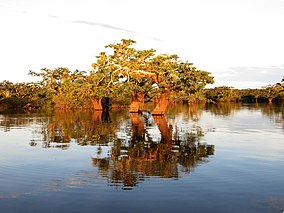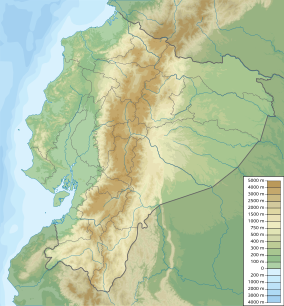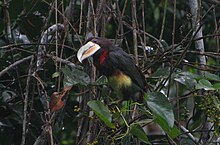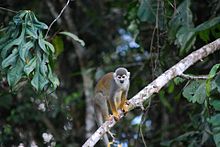306:
144:
497:, an affluent of the Amazon. The Secoyas, who originally lived within the borders of what is now the reserve, currently live just outside of the reserve. A few Siona, Secoya, and Cofan folk are still knowledgeable about the use of natural medicines, but unfortunately, that knowledge is fading away rapidly among the younger generations. Additionally, new arrivals have settled in the reserve, including smallholders, and Quichua Indians. Until the 1980s, these communities have mainly lived of
461:
Cofan tribe from their Cofan Lodge. These lake and marsh areas have a different flora and fauna than the forests on the higher grounds in between these wetlands and at the upper watershed. While the inundated forests are relatively poor in species - but many more of each species, particularly wildlife -, the higher grounds have some of the highest number of trees per hectare on earth. On one location in neighbouring Yasuní National Park, 307 species of trees/hectare were counted.
322:
997:
151:
335:
25:
314:
131:
297:, which is considered the most diverse park in the world. However, such claims must be met with caution, as insufficient data of other areas exist to scientifically compare the diversity of areas. Moreover, to the incidental visiting tourist or even professional biologist such differences are irrelevant because all areas close to the Andes are incredibly rich in species.
473:
mid-December to the end of the middle of March, but the beginning and the end of the dry season varies considerable. The climate corresponds to a wet tropical forest, with precipitation of about 3000 mm or 180 inches per year, and humidity ranging from 85% to 95%. The annual temperature oscillates around 25 °C or 77 °F.
456:
The current number of registered bird species is under debate, some claiming 530 species while others suggest that more than 580 species have been observed, but nobody is known to keep solid records. At the peak of the wet season, thousands of hectares of forest become inundated, forming an El Dorado
287:
with rather unusual ecological characteristics. Located at the foothills of the Andes, it is different from any other Amazon protected area in the world. The area encompasses a poorly drained plain with a network of periodically inundated forests, lakes and creeks. Such conditions are rare so close
472:
along with their tributaries. Aforementioned two lake systems, both north of the
Aguarico River have 13 lakes, while the largest lake, Zancudo Coche is South of the river. In the rainforest of the Amazon of Ecuador, it is difficult to speak of a rainy season, but a dryer season runs from somewhere
460:
There are two lake areas in the park. The nearest network of lakes is in the eastern part of the park, and can be conveniently reached from Lago Agrio over an asphalt road. The other lake network is located at the border with Peru, and requires some extensive travel, which is now organized by the
279:
From east to west, the elevation gently slopes from about 326 meters to slightly under 177 m above sea level and has an area of 590,112 hectares (5,900 km2 or 2,330 square miles). The upper watershed being still close to the Andes, the weather seems slightly milder than more eastern parts of the
457:
for an estimated number 350 fish species, two species of cayman, boa constrictors and anacondas, while countless frogs and toads sing their never-ending concerts. Dolphins have been seen swimming deep in the inundated forest during high water, as they follow the fishes.
288:
to the Andes, where the drainage in the foothills prevents the development of swamps and lakes. Given its proximity to the mountains, combined with a slightly cooler and wetter climate it may be expected to have a partly different
276:. It was decreed on 26 July 1979 as part of the creation of the national protected areas system based on the recommendations of the FAO report on the "National Strategy on the Conservation of Outstanding Wild Areas of Ecuador".
418:(4) semi-permanently inundated forests flooded by black-water rivers, or igapó (Pires and Prance, 1985) and dominated by macrolobium trees which are the homes to countless epiphytes, herons, blue and yellow macaws and hoatzins;
292:
than other areas in the upper Amazon watershed. As all protected areas in the Amazon region, the area has a high biodiversity, but possibly a bit lower than better drained protected areas like the neighbouring
440:
All large amazon mammals are present: the lowland tapirs, two species of deer, all Amazon cats, including jaguars and pumas, capibaras, two species of dolphins, manatees, both otter species, giant otter
950:
924:
945:
403:(1) well-drained forest located on small hills in the upper watershed and the areas between the semi-inundated planes, particularly up-stream from the park entrance at "the Cuayabeno Bridge";
903:
509:. Since then, the life of the indigenous communities in the Cuyabeno Wildlife Reserve has changed due to improved access with roads built for oil exploitation and earnings from ecotourism.
836:
929:
594:
893:
826:
846:
888:
966:
919:
1046:
706:
449:
195:
1041:
571:
421:(5) Submerged herbal vegetation found along lake and river shores; they consist of rooted water plants and shrubs that endure long-term submersion;
540:
143:
1021:
1031:
89:
356:
42:
61:
699:
586:
1036:
68:
790:
557:
280:
Amazon, with temperatures a bit lower during the day and at night usually cooling to the low twenties (°C) or seventies (°F).
841:
831:
75:
1026:
692:
622:
409:(3) seasonally flooded forests or swamps, traversed by sediment-poor black-water rivers with a vegetation dominated by
57:
764:
715:
602:
382:
108:
364:
856:
821:
433:(9) semi-permanent lakes - the largest being the Cuyabeno Lake - that most of the years fall at least partly dry.
872:
360:
46:
453:), etc. Monkeys are represented by 10 species, while rodents and bats are represented by dozens of species.
851:
816:
679:
305:
811:
636:
982:
465:
82:
739:
744:
754:
749:
345:
349:
284:
35:
774:
769:
325:
An example of an ecolodge, the
Cuyabeno Lodge, the first lodge in the Cuyabeno Wildlife Reserve.
734:
729:
669:
443:
437:
Black waters (both rivers and lakes) will turn sediment-laden during periods of high rainfall.
1051:
485:
live in the area of the upper
Cuyabeno lakes network and along the Tarapuy river, while the
265:
171:
759:
558:"Cuyabeno Fauna Production Reserve | Sistema Nacional de Áreas Protegidas del Ecuador"
541:"Estrategia Preliminar para la Conservación de Áreas Silvestres Sobresalientes del Ecuador"
406:(2) forests seasonally flooded by sediment-rich rivers, or varzea (Pires and Prance, 1985);
294:
8:
430:(8) permanent lakes that rarely fall dry, primarily Zancudo Coche along the Río Aguarico;
289:
424:(6) "coffee-and-milk" coloured sediment-rich rivers, the largest being the Río Aguarico;
598:
411:
273:
179:
249:
269:
261:
256:) is the second largest reserve of the 56 national parks and protected areas in
183:
175:
486:
1001:
494:
469:
1015:
684:
490:
210:
197:
608:
482:
795:
526:
396:
321:
427:(7) "black-water" sediment-poor rivers, most notably the Zábalo River;
595:
International Union for
Conservation of Nature and Natural Resources
334:
317:
The
Saimiri Sciureus, common monkey in the Cuyabeno Wildlife Reserve
24:
313:
506:
502:
498:
257:
167:
283:
The
Cuyabeno Wildlife Reserve is an important nature reserve in
130:
664:
546:. February 1976. UNDP/FAO-ECU/71/527 – via birdlist.org.
674:
309:
Pteroglossus azara in
Cuyabeno Wildlife Reserve, Ecuador
623:"6 Best Amazon Rainforest Vacations, [Review]"
572:"CUYABENO NATIONAL RESERVE [ECUADOR's AMAZON]"
589:. In Prance, Ghillean T.; Lovejoy, Thomas E. (eds.).
49:. Unsourced material may be challenged and removed.
150:
1013:
675:News and information about Ecotourism worldwide
670:Cooperation for Sustainable Development Website
714:
587:"The vegetation types of the Brazilian Amazon"
700:
464:The river system covers the rivers Aguarico,
680:Ecuatorian Association of Ecotourism Website
584:
363:. Unsourced material may be challenged and
707:
693:
1047:Tourist attractions in Sucumbíos Province
585:Pires, J.M.; Prance, Ghillean T. (1985).
383:Learn how and when to remove this message
254:Reserva de Producción Faunística Cuyabeno
109:Learn how and when to remove this message
1042:Tourist attractions in Orellana Province
320:
312:
304:
1014:
665:Cuyabeno National Park's Official Site
688:
361:adding citations to reliable sources
328:
47:adding citations to reliable sources
18:
1022:Protected areas established in 1979
13:
300:
14:
1063:
658:
995:
333:
149:
142:
129:
23:
1032:Geography of Sucumbíos Province
34:needs additional citations for
1037:Geography of Orellana Province
629:
615:
578:
564:
550:
533:
519:
1:
512:
637:"A local's guide to Ecuador"
476:
7:
939:National Recreational Parks
58:"Cuyabeno Wildlife Reserve"
10:
1068:
1027:Nature reserves in Ecuador
716:Protected areas of Ecuador
591:Key Environments: Amazonia
991:
975:
959:
938:
912:
881:
865:
804:
783:
722:
493:live on the banks of the
447:) and neotropical otter (
246:Cuyabeno Wildlife Reserve
234:
226:
189:
163:
137:
128:
124:Cuyabeno Wildlife Reserve
123:
16:Ecuadorian nature reserve
260:. It is located in the
925:Muisne River Mangroves
444:Pteronura brasiliensis
326:
318:
310:
253:
866:Geobotanical Reserves
395:There are nine major
324:
316:
308:
357:improve this section
295:Yasuni National Park
43:improve this article
805:Ecological Reserves
784:Biological Reserves
765:Sumaco Napo-Galeras
290:species composition
207: /
1002:Ecuador portal
930:Santa Clara Island
327:
319:
311:
266:Sucumbíos Province
211:0.1167°S 75.8333°W
172:Sucumbíos Province
1009:
1008:
882:Wildlife Reserves
842:Cotacachi Cayapas
832:Churute Mangroves
450:Lutra longicaudis
412:Mauritia flexuosa
393:
392:
385:
274:Orellana Province
242:
241:
216:-0.1167; -75.8333
180:Orellana Province
119:
118:
111:
93:
1059:
1000:
999:
998:
960:Binational Parks
913:Wildlife Refuges
709:
702:
695:
686:
685:
652:
651:
649:
648:
633:
627:
626:
619:
613:
612:
582:
576:
575:
568:
562:
561:
554:
548:
547:
545:
537:
531:
530:
523:
388:
381:
377:
374:
368:
337:
329:
222:
221:
219:
218:
217:
212:
208:
205:
204:
203:
200:
153:
152:
146:
133:
121:
120:
114:
107:
103:
100:
94:
92:
51:
27:
19:
1067:
1066:
1062:
1061:
1060:
1058:
1057:
1056:
1012:
1011:
1010:
1005:
996:
994:
987:
976:Marine Reserves
971:
955:
934:
908:
877:
861:
800:
779:
718:
713:
661:
656:
655:
646:
644:
635:
634:
630:
621:
620:
616:
605:
583:
579:
570:
569:
565:
556:
555:
551:
543:
539:
538:
534:
527:"Ambiente-agua"
525:
524:
520:
515:
479:
389:
378:
372:
369:
354:
338:
303:
301:Characteristics
270:Aguarico Canton
262:Putumayo Canton
215:
213:
209:
206:
201:
198:
196:
194:
193:
184:Aguarico Canton
176:Putumayo Canton
170:
159:
158:
157:
156:
155:
154:
115:
104:
98:
95:
52:
50:
40:
28:
17:
12:
11:
5:
1065:
1055:
1054:
1049:
1044:
1039:
1034:
1029:
1024:
1007:
1006:
992:
989:
988:
986:
985:
979:
977:
973:
972:
970:
969:
963:
961:
957:
956:
954:
953:
948:
942:
940:
936:
935:
933:
932:
927:
922:
916:
914:
910:
909:
907:
906:
901:
896:
894:Corazón Island
891:
885:
883:
879:
878:
876:
875:
869:
867:
863:
862:
860:
859:
854:
849:
844:
839:
834:
829:
827:Cayapas Mataje
824:
819:
814:
808:
806:
802:
801:
799:
798:
793:
787:
785:
781:
780:
778:
777:
772:
767:
762:
757:
752:
747:
742:
737:
732:
726:
724:
723:National Parks
720:
719:
712:
711:
704:
697:
689:
683:
682:
677:
672:
667:
660:
659:External links
657:
654:
653:
628:
614:
603:
577:
563:
549:
532:
517:
516:
514:
511:
478:
475:
435:
434:
431:
428:
425:
422:
419:
416:
407:
404:
399:in Cuyabeno:
391:
390:
341:
339:
332:
302:
299:
240:
239:
236:
232:
231:
228:
224:
223:
191:
187:
186:
165:
161:
160:
148:
147:
141:
140:
139:
138:
135:
134:
126:
125:
117:
116:
31:
29:
22:
15:
9:
6:
4:
3:
2:
1064:
1053:
1050:
1048:
1045:
1043:
1040:
1038:
1035:
1033:
1030:
1028:
1025:
1023:
1020:
1019:
1017:
1004:
1003:
990:
984:
981:
980:
978:
974:
968:
965:
964:
962:
958:
952:
949:
947:
944:
943:
941:
937:
931:
928:
926:
923:
921:
918:
917:
915:
911:
905:
902:
900:
897:
895:
892:
890:
887:
886:
884:
880:
874:
871:
870:
868:
864:
858:
857:Mache Chindul
855:
853:
850:
848:
845:
843:
840:
838:
837:Cofán Bermejo
835:
833:
830:
828:
825:
823:
820:
818:
815:
813:
810:
809:
807:
803:
797:
794:
792:
789:
788:
786:
782:
776:
773:
771:
768:
766:
763:
761:
758:
756:
753:
751:
748:
746:
743:
741:
738:
736:
733:
731:
728:
727:
725:
721:
717:
710:
705:
703:
698:
696:
691:
690:
687:
681:
678:
676:
673:
671:
668:
666:
663:
662:
642:
638:
632:
624:
618:
610:
606:
604:9780080307763
600:
596:
592:
588:
581:
573:
567:
559:
553:
542:
536:
528:
522:
518:
510:
508:
504:
500:
496:
492:
488:
484:
474:
471:
467:
462:
458:
454:
452:
451:
446:
445:
438:
432:
429:
426:
423:
420:
417:
414:
413:
408:
405:
402:
401:
400:
398:
387:
384:
376:
366:
362:
358:
352:
351:
347:
342:This section
340:
336:
331:
330:
323:
315:
307:
298:
296:
291:
286:
281:
277:
275:
271:
267:
263:
259:
255:
251:
247:
237:
233:
229:
225:
220:
192:
188:
185:
181:
177:
173:
169:
166:
162:
145:
136:
132:
127:
122:
113:
110:
102:
99:February 2013
91:
88:
84:
81:
77:
74:
70:
67:
63:
60: –
59:
55:
54:Find sources:
48:
44:
38:
37:
32:This article
30:
26:
21:
20:
1052:Upper Amazon
993:
898:
822:Cayambe Coca
645:. Retrieved
643:. 2021-09-03
641:CN Traveller
640:
631:
617:
609:ResearchGate
607:– via
590:
580:
566:
552:
535:
521:
480:
463:
459:
455:
448:
442:
439:
436:
410:
394:
379:
370:
355:Please help
343:
282:
278:
245:
243:
105:
96:
86:
79:
72:
65:
53:
41:Please help
36:verification
33:
951:Parque Lago
796:Maquipucuna
745:Llanganates
268:and in the
235:Established
214: /
190:Coordinates
1016:Categories
946:El Boliche
889:Chimborazo
791:Limoncocha
755:Podocarpus
750:Machalilla
647:2021-09-05
513:References
489:, and the
466:San Miguel
397:ecosystems
202:75°50′00″W
69:newspapers
983:Galápagos
967:El Condor
904:El Salado
873:Pululahua
852:Illinizas
817:Arenillas
740:Galápagos
477:Ethnology
344:does not
199:0°07′00″S
920:Pasochoa
899:Cuyabeno
847:El Ángel
812:Antisana
735:Cotopaxi
495:Aguarico
470:Cuyabeno
373:May 2015
285:Amazonia
230:5900 km²
164:Location
507:hunting
503:farming
499:fishing
491:Secoyas
365:removed
350:sources
272:in the
264:in the
258:Ecuador
250:Spanish
168:Ecuador
83:scholar
775:Yasuní
770:Yacurí
760:Sangay
601:
487:Cofans
483:Sionas
415:palms;
85:
78:
71:
64:
56:
730:Cajas
544:(PDF)
90:JSTOR
76:books
599:ISBN
505:and
481:The
468:and
348:any
346:cite
244:The
238:1979
227:Area
62:news
359:by
45:by
1018::
639:.
597:.
593:.
501:,
252::
182:,
178:;
174:,
708:e
701:t
694:v
650:.
625:.
611:.
574:.
560:.
529:.
441:(
386:)
380:(
375:)
371:(
367:.
353:.
248:(
112:)
106:(
101:)
97:(
87:·
80:·
73:·
66:·
39:.
Text is available under the Creative Commons Attribution-ShareAlike License. Additional terms may apply.



